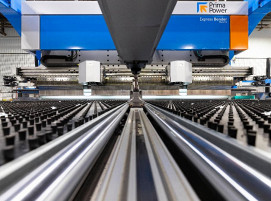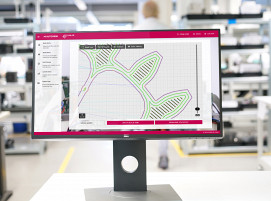
Plastic Valves Market Outlook
As industries worldwide undergo rapid modernization, the demand for efficient, lightweight and corrosion-resistant fluid control systems has surged. The plastic valves market is at the center of this industrial evolution, offering smart, durable alternatives to traditional metal valves. These valves, made from materials such as PVC, CPVC, PP, and PVDF, are gaining widespread adoption across sectors including water treatment, chemical processing, pharmaceuticals, food & beverage and agriculture. The global plastic valves market was valued at US$ 2.2 billion in 2021. The market is projected to grow at a robust CAGR of 5.6 % between 2022 and 2032, reaching approximately US$ 3.96 billion by the end of 2032.
As of 2021, the top four plastic valve manufacturers collectively accounted for 42 % of the global market share, reflecting a moderately consolidated competitive landscape. Notably, revenue generated from plastic valves market represents around 3.4 % of the overall global industrial valves market, underlining their growing importance in modern flow control applications.
Rising demand across industries
Plastic valves are increasingly being used in industries where chemical resistance and non-metallic components are vital. Water and wastewater treatment remains a dominant application area, with municipalities and private utilities focusing on infrastructure upgrades that incorporate low-maintenance, corrosion-resistant systems. Similarly, the chemical processing industry requires components that can withstand harsh environments without degrading. Here, plastic valves have proven to be more reliable and cost-efficient over time.
The food & beverage and pharmaceutical sectors are also contributing to market expansion. Stringent hygiene and safety regulations have prompted manufacturers to choose non-corrosive, non-toxic materials. Plastic valves offer the ideal solution, with easy installation and minimal contamination risk. Furthermore, their compatibility with automation technologies enhances operational efficiency, aligning with Industry 4.0 trends.
Technological advancements enhancing market potential
Technological advancements are reshaping the plastic valves landscape. Smart valves equipped with sensors, automation features and remote monitoring capabilities are transforming traditional flow control systems into intelligent solutions. These next-gen valves allow for real-time data analysis, predictive maintenance, and energy-efficient operations. The integration of Industrial Internet of Things (IIoT) and smart control technologies will play a pivotal role in driving market growth. Innovations such as solenoid-controlled plastic valves and electronically actuated systems are creating opportunities for manufacturers to differentiate themselves in a competitive market.
Advantages over traditional materials
Plastic valves offer a number of advantages over metal counterparts. They are lightweight, resistant to corrosion and chemical damage and often require lower installation and maintenance costs. These attributes make them especially suitable for applications where metal components might fail or require frequent servicing. Additionally, plastic valves exhibit superior thermal and electrical insulation properties. In high-risk industrial environments, these qualities enhance safety and reduce the risk of accidents. Moreover, due to their low thermal conductivity, plastic valves help in maintaining process stability in temperature-sensitive operations.
Key market drivers
Several key factors are driving the growth of the plastic valves market:
- Corrosion resistance and durability: Increasing preference for materials that withstand aggressive chemicals and moisture.
- Cost-efficiency: lower production, transportation and maintenance costs compared to metal valves.
- Sustainability and environmental regulations: rising awareness and government regulations promoting eco-friendly materials in construction and manufacturing.
- Technological Integration: surge in demand for smart, automated flow control systems across industrial applications.
Regional insights
North America and Europe continue to hold a significant share of the plastic valves market due to their advanced industrial infrastructure and early adoption of innovative technologies. The United States, in particular, has seen growing use of plastic valves in water utilities and the chemical sector. Asia-Pacific, however, is emerging as the fastest-growing market, fuelled by rapid industrialization, urban infrastructure development, and water management initiatives in countries like China, India, and Southeast Asian nations. According to Persistence Market Research, the region is expected to dominate the global plastic valves market in terms of volume and revenue growth.
Competitive landscape
The global plastic valves market is fragmented, with a mix of large multinational companies and regional players. Key manufacturers are focusing on strategic acquisitions, product innovation, and geographical expansion to strengthen their market position. Notable players in the market include:
- GF Piping Systems
- Asahi/America
- Nibco Inc.
- Cepex (Fluidra)
- Hayward Flow Control
- Plast-O-Matic Valves, Inc.
- AVK Holding A/S
Many of these companies are investing heavily in R&D to develop high-performance plastic valves that cater to specific industry needs. Smart valve integration and sustainability-focused designs are becoming critical differentiators.
Challenges to address
Despite its growth trajectory, the plastic valves market faces certain challenges. Temperature and pressure limitations of plastic materials restrict their use in high-performance applications. In some heavy industrial environments, metal valves are still preferred due to their superior strength and heat resistance. Moreover, quality control, product standardization, and counterfeit issues in emerging markets remain concerns that need to be addressed through better regulatory oversight and industry collaboration.
Future outlook
The plastic valves market is well-positioned for sustained growth beyond 2025. Increasing emphasis on smart infrastructure, green technologies and cost-effective solutions will continue to boost demand. Innovations in high-performance plastics and composite materials will help overcome current limitations, expanding the scope of plastic valves in critical applications. As industries move toward digitization and sustainable development, the adoption of intelligent plastic valve systems will become a cornerstone of next-gen fluid control architecture. With ongoing advancements in material science and IoT integration, the market is expected to evolve dynamically, offering lucrative opportunities for stakeholders across the value chain.
(Source: Persistence Market Research)
Schlagworte
IndustryJoining PlasticsPlasticsTransformation






